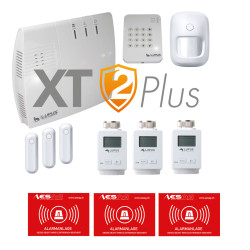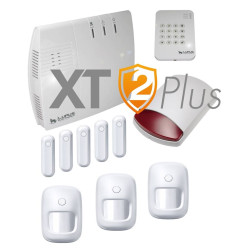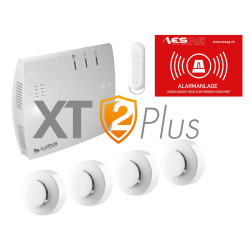- Alarm Systems (Radio & Wire)
- 122 likes
- 7497 views

The best burglary protection is discreet and secure, without giving the feeling of being locked in. All of this is provided by a combination of mechanical and electronic security technology. What should you look out for?
Like any surveillance technology, burglary protection is only as effective as its weakest link. The electronics in the smart home and a good alarm system help to deter burglars, minimize the time it takes to break in, and get help. If you are dealing with stubborn thieves, they will accept the challenge and still break into easily accessible rooms. That is why you should not forget mechanical burglary protection in addition to electronic security technology. This includes relatively easy-to-implement protective measures, especially on windows and doors. Burglary protection is only effective when the mechanical and electronic security systems work together.
Mechanical security systems for burglary protection: Where are they used?
Anyone who is looking into burglary protection will probably not be able to see the forest for the trees at first. Therefore, first look at all the possible weak points in and around the house or apartment. Thinking a little like a burglar is definitely an advantage. Check all openings in the building and select the appropriate protection. Note that mechanical security systems do not deter thieves. Electronic systems such as the LUPUSEC alarm systems perform this task. The mechanics simply add another hurdle. If you are dealing with a beginner, they will be deterred by the mere presence of an obstacle. Professionals, on the other hand, are hardly bothered by them. The only thing that helps here is alarm systems with surveillance cameras that quickly alert help, attract attention and record the crime.
If you want to install mechanical security systems for additional burglary protection, you can choose from seven resistance classes. The so-called RC classes (RC1 to 6) are defined in DIN EN 1627. While classes RC 1 N to RC 3 are more suitable for private areas, classes RC 4 to RC 6 are used in particular in commercial areas.
- Security class RC 2 is recommended for doors and gates, or RC 3 if higher security is required. This means that security cylinder locks with profile cylinders, protective fittings, latch locks, door gap locks, hinge locks and a door viewer are used. It is important not to forget the side entrance doors and to also secure the garage doors. However, there is no uniformly regulated RC class for this.
- The same RC classes 2 and 3 apply to windows and French doors as to doors. These are characterized by mushroom head pin fittings, burglar-resistant glazing (P4A or P5A glass) and lockable window handles. On the ground floor, drilling protection for the window mechanism is also recommended.
- For roller shutters, you should make sure that they are protected against being pried open or pushed up. Burglar-resistant slats provide greater security.
- Grills or metal mesh are the best choice for light shafts. Grilles are also divided into RC classes and offer sufficient protection for your home in class RC 2 or 3. Metal mesh is not classified. Pay attention to the screwing or anchoring of the frame directly into the masonry and to fixed, lockable grilles mounted on the room side, whose steel mesh cannot be cut open by locking bars made of flat steel.
- Animal flaps for dogs or cats are usually installed directly in doors or windows and, unless they were installed later, are also subject to RC classes. Please note that they pose a fundamental safety risk overall.
Mechanical systems can always be broken into. Therefore, it is important to also install electrical security systems to protect against burglary.
What are electrical safety systems and what happens in the event of a power failure?
In contrast to locks, grilles, etc., this is not just about additional hurdles, but about deterrence and surveillance. This is generally called an alarm system. As already described in an earlier article about burglary protection in the home, there is a lot more to it than that. Alarm systems are a combination of various cameras, sensors, warning and motion detectors. These work in a network and form an alarm chain that warns you, protects you and, if you want, calls for help. If you decide to have an intelligent home and use the Smart Home at the same time, you can achieve maximum security with LUPUSEC. We offer you various electrical security systems for this:
- Our various cameras for indoor and outdoor video surveillance. They monitor your home and allow you worldwide access and control.
- The mechanical locking element acts as an additional lock for the door and can be connected to and controlled via radio to the LUPUSEC control center.
- The LUPUSEC window and door contacts V2 check whether a door or window is closed or open, thus expanding the purely mechanical protection.
- You can also get vibration detectors and glass break detectors to match.
- There are also various sirens and warning lights. They deter and warn at the same time. A visible siren alone increases your security enormously. A security lock alone cannot do that!
But what happens in the event of a power failure? Is your home then unprotected? Of course not! Intelligent alarm systems simply switch to battery operation, as do our LUPUSEC systems.
Which security system makes sense for you?
Both security systems build on each other and complement each other. The only sensible way to provide effective protection against burglary is to combine mechanical security devices and electrical security systems. Detailed advice and professional installation are also part of this. We are happy to help!















